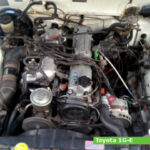
A 75.0 mm (2.95 in) cylinder bore and 75.0 mm (2.95 in) piston stroke give the 1G-E engine a total of 1,988 cc of displacement. Compression ratio rating is from 9.2:1.
This engine produced 105.0 PS (77 KW; 103.5 HP) at 5,200 rpm of maximum horsepower and 160 Nm (16.32 kg·m; 118.08 ft·lb) at 4,000 rpm of peak torque.
The Toyota 1G-E features:
- Cast-iron cylinder block
- Aluminum cylinder head
- SOHC design (Single belt-driven overhead camshafts)
- Multi-Point fuel injection
- Electronic throttle body (3-rd gen.)
- Forced lubrication system
- Liquid cooling system
- Electric starter
General information
| Engine Specifications | |
| Engine model | 1G-E |
| Engine type | 4-stroke, SOHC, straight-six |
| Displacement | 2.0 L, 1,988 cm3 (121.3 cu in) |
| Max. horsepower | 105.0 PS (77 KW; 103.5 HP) at 5,200 rpm |
| Max. torque | 160 Nm (16.32 kg·m; 118.08 ft·lb) at 4,000 rpm |
| Cooling system | Liquid-cooled |
| Lubricating system | Forced lubrication |
| Ignition system | – |
| Fuel system | Multi-Point fuel injection) |
| Fuel used | Gasoline |
| Starting system | Electric starter |
| Firing order: | 1-5-3-6-2-4 |
| Dimensions (L x W X H) | – |
| Dry weight | 180 kg (397 lbs) |
Cylinder Block and Head
| Cylinder block | |
| Cylinder block alloy: | Cast-iron |
| Compression ratio: | 9.2:1 |
| Cylinder bore: | 75.0 mm (2.95 in) |
| Piston stroke: | 75.0 mm (2.95 in) |
| Cylinder internal diameter (standard): | 75.000-75.030 mm (2.9528-2.9539 in) |
| Piston skirt outer diameter (standard): | 74.955-74.985 mm (2.9510-2.9520 in) |
| Number of piston rings (compression / oil): | 2/1 |
| Ring side clearance (Top): | 0.040-0.080 mm (0.0016-0.0031 in) |
| Ring side clearance (Second): | 0.030-0.070 mm (0.0012-0.0028 in) |
| Ring end gap (Top): | NPR: 0.150-0.390 mm (0.0059-0.0153 in) Riken: 0.150-0.440 mm (0.0059-0.0173 in) |
| Ring end gap (Second): | NPR: 0.150-0.390 mm (0.0059-0.0153 in) Riken: 0.100-0.390 mm (0.0039-0.0153 in) |
| Ring end gap (Oil): | NPR: 0.200-0.590 mm (0.0079-0.0232 in) Riken: 0.300-0.990 mm (0.0118-0.0390 in) |
| Number of main bearings: | 7 |
| Crankshaft main journal diameter: | 54.985-55.000 mm (2.1647-2.1653 in) |
| Crankpin journal diameter: | 41.985-42.000 mm (1.6529-1.6535 in) |
| Cylinder head | |
| Cylinder head alloy: | Aluminum |
| Valve arrangement: | SOHC, belt driven |
| Valves: | 2,(12 valves in total) |
| Valve head diameter (INTAKE): | – |
| Valve head diameter (EXHAUST): | – |
| Valve length (INTAKE): | 93.100-93.700 mm (3.6653-3.689 in) |
| Valve length (EXHAUST): | 93.000-93.600 mm (3.6614-3.685 in) |
| Valve steam diameter (INTAKE): | 5.970-5.985 mm (0.235-0.2356 in) |
| Valve steam diameter (EXHAUST): | 5.965-5.980 mm (0.2348-0.2354 in) |
| Valve spring free length (INTAKE): | Inner: 35.50 mm (1.3976 in) Outer: 38.00 mm (1.4960 in) |
| Valve spring free length (EXHAUST): | Inner: 35.50 mm (1.3976 in) Outer: 38.00 mm (1.4960 in) |
Tightening torque
| Tightening torque specs | |
| Cylinder head: | 60-70 Nm (6.1-7.1 kgf·m; 44.3-51.7 ft·lb) |
| Main bearing cap bolts: | 60 Nm (6.1 kg·m; 44.3 lb·ft) |
| Connecting rods cap bolts: | 50 Nm (5.1 kg·m; 36.9 lb·ft) |
| Spark plug: | 18 N·m (1.8 kg·m, 13.3 lb·ft) |
Service Data
| Cylinder compression pressure | |
| Standard: | 13.0 kg/cm2, 185 psi/ 300 rpm |
| Minimum: | 10.0 kg/cm |
| Oil system | |
| Lubrication system: | Forced lubrication |
| Recommended engine oil, SAE: | 10W-30 |
| Oil type, API: | SG or better |
| Engine oil capacity: | 3.9 l (4.1 US qts, 3.4 Imp qts) |
| Oil change interval, km (miles): | 10,000 (6,000) |
| Ignition system | |
| Spark plug: | DENSO W20EXR-U, NGK BPR6EY |
| Spark plug torque: | 18 N·m (1.8 kg·m, 13.3 lb·ft) |
Vehicle applications
| Model | Years Produced |
| Toyota Cressida (X70) | 1984-1988 |
| Toyota Crown (S130) | 1987-1991 |
| Toyota Mark II Van (X70) | 1984-1991 |
 Author:
Author:
Be the first to comment